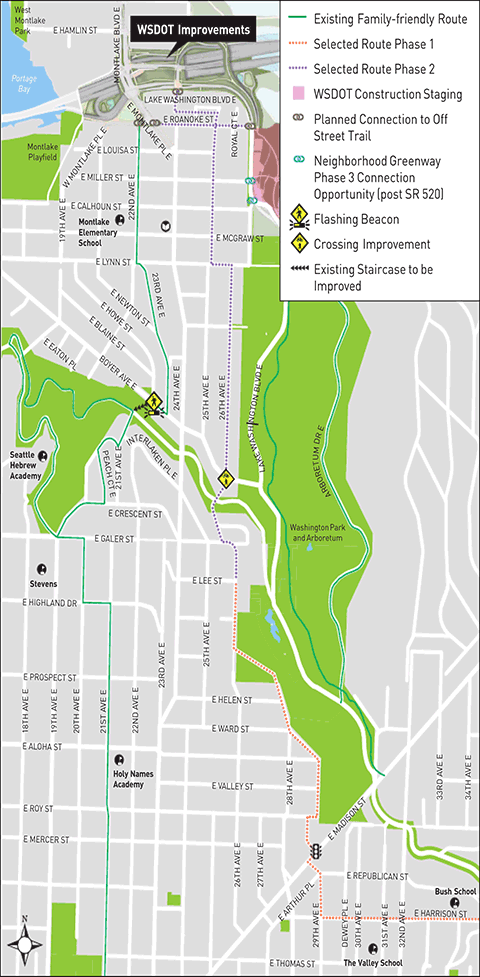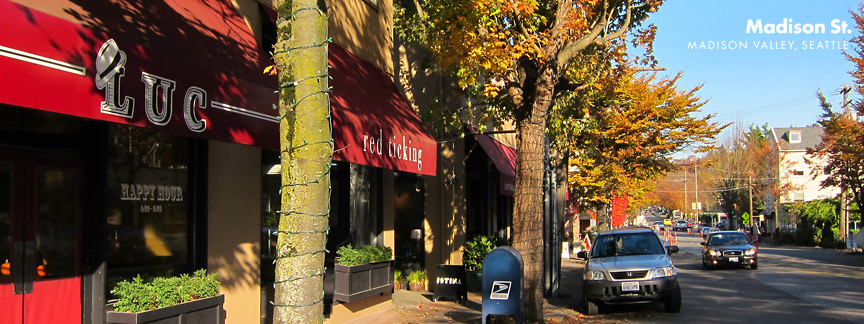
Please vote to support neighborhood traffic safety in Madison Valley by Feb 28
Hello Neighbors,
You have an immediate opportunity to take just a few minutes now to show your support for the residents of Madison Valley in their multi-year effort to both curb the onslaught of abundant aggressive neighborhood cut-through traffic, while also creating a safe walking and biking route connecting Montlake with the recent improvements on E Harrison St in Madison Valley.
All you have to do is to go to the project voting tool provided by the city and register your 100% support for the grant submitted by the people who live along the non-arterial Lake Washington Loop signed bicycle route in Madison Valley. The survey tool consists of a slider and comment area. Drag it to the right to register your support for making this project a priority. It helps if you enter a reason for support. Please choose one of the reasons below or create one in your own voice (always a good thing).
This community-driven effort is being done to:
1. Reduce aggressive cut-through driving behavior on our non-arterial streets to restore peace and tranquility to our neighborhood’s streets,
2. Provide safe routes to schools for both children, parents and teachers,
3. Make it safe and pleasant for residents to walk or bike to local businesses, freeing up parking for more customers,
4. Create a truly safe pedestrian crossing of E Madison St at 29th Ave E.
5. Improve safety for all area residents who currently rely on this route to get to work, school and transit.
A little history: This project was started five years ago as part of the Madison Park/Valley Neighborhood Greenways program. Many of you attended one or more of the many community meetings that were held to get your input on how you travel inside and between neighborhoods — in all modes of transportation.
In early 2018 a group of students from The Bush School helped compile the large amount of data which included, anecdotal information from over a hundred residents, and data from traffic studies conducted in various locations around Madison Valley.
Based on this information it was determined that the proposed North / South route was favored by the neighborhoods and deemed the most efficient from an implementation standpoint.
The proposed route is:
• South of Madison Street – 29th Ave East beside Café Flora and continuing down East Harrison Street.
• North of Madison Street – 29th Ave East and 26th Ave East to Montlake at E Boyer St.
A grant was awarded in 2015 to Madison Valley Friends for Safer Streets, to hire an engineering consultant to define which traffic calming measures would be most effective along the route. In concert with SDOT, it was determined that a combination of measures were needed in different locations.
The suggested measures include:
• Reconfiguration of intersections along the route (most importantly the crossing at 29th and Madison Street)
• ADA curb ramps as needed
• Low-profile speed humps
• Signage and in-street wayfinding
• Sideway and pavement repair along the route
Please note: We are NOT talking about a dedicated bike lane on East Madison Street. These improvements will not interfere with arterial traffic movement or change the function or capacity of the main traffic and freight routes we all depend upon.
Madison Valley parents stated this is the most effective route to get kids who live in the Valley to McGilvra Elementary School. Students from The Bush School came to the same conclusion for their school.
Some people have commented that there is a path that runs through the Arboretum. This path does not work as the sole North / South connection because it does not provide the cut-through traffic mitigation relief provided by greenways treatments such as those already implemented on 37th Ave E by McGilvra Elementary School. Nor does it connect the currently cut-off residents north of E Helen St to the MV business district and schools.
Residents on 37th Ave E in Madison Park who have a completed greenway segment have reported near complete elimination of aggressive speeding a great reduction in cut-through traffic.
The city of Seattle has allocated some of your taxpayer dollars to the Neighborhood Street Fund and Move Seattle. This money is going to be spent on various projects around the city anyhow, we want to see our fair share of the benefits applied in Madison Valley. By showing support for this project, we have a chance of seeing that money go to infrastructure improvements that will benefit Madison Park, Madison Valley, Montlake, and Madrona - the neighborhoods we call home.
Please take a minute and indicate that you’re 100% for safer and more peaceful non-arterial streets within Madison Valley.
Take the survey here: https://nsf.consider.it/2019-117?results=true
This article from last year is full of good information about this project. https://madisonparktimes.com/Content/News/Top-Stories/Article/SDOT-collecting-more-traffic-data-for-Lake-Washington-Loop-Greenway/26/284/31097
This is time-sensitive — the survey closes at the end of February! We appreciate everyone who has supported this many-year effort. We will continue to plod along, as that is how these improvements get done in Seattle.
If you have specific questions, please post them below or reach out to me directly and I’ll be happy to answer your questions. Many of them may be already answered in Sally Bagshaw’s blog post https://bagshaw.seattle.gov/2011/04/11/bicycle-greenways-questions-possible-answers-and-food-for-thought/.
Examiner's Ruling on the Appeal by Save Madison Valley
The Seattle Hearing Examiner has issued his decision on Save Madison Valley’s appeal of the master use permit for the City People’s property.
The examiner found that the city did not do enough work to determine if the project will create significant environmental impacts in two areas: drainage/flooding issues in the Valley, and lighting/shadow impacts to the P-Patch. The examiner told the city (SDCI) to go back and do more analysis on those two specific issues, and re-issue a determination if the project is likely to have significant environmental impacts under Washington’s State Environmental Policy Act (SEPA). Other SEPA issues like the slope were affirmed (the examiner agreed the city studied it enough, and no further action is necessary).
The examiner upheld the city’s decision around design review and design guidelines, and denied all aspects of SMV’s appeal in those regards.
The findings and decision can be found here: https://web6.seattle.gov/Examiner/case/document/11758
And the record of proceedings for the appeal including the decision above is available at https://web6.seattle.gov/Examiner/case/MUP-18-020.



prv98ivi5oxedvvge [email protected]